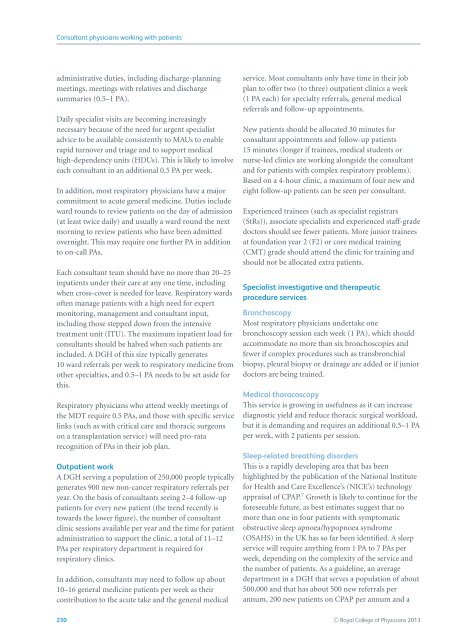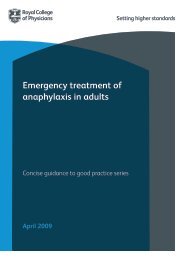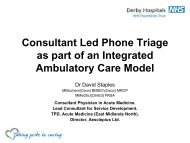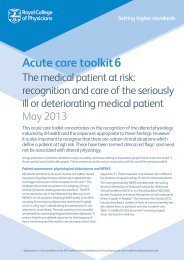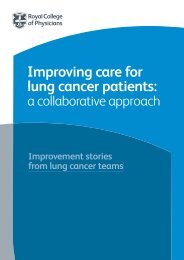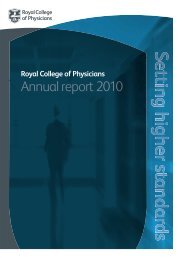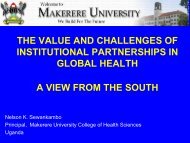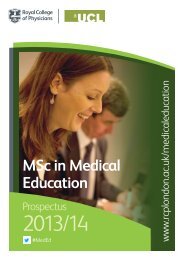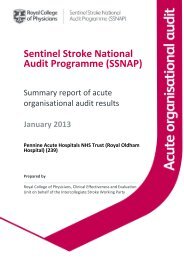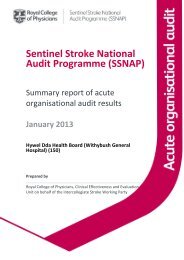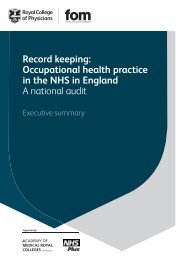Consultant physicians working with patients - Royal College of ...
Consultant physicians working with patients - Royal College of ...
Consultant physicians working with patients - Royal College of ...
Create successful ePaper yourself
Turn your PDF publications into a flip-book with our unique Google optimized e-Paper software.
<strong>Consultant</strong> <strong>physicians</strong> <strong>working</strong> <strong>with</strong> <strong>patients</strong>administrative duties, including discharge-planningmeetings, meetings <strong>with</strong> relatives and dischargesummaries (0.5–1 PA).Daily specialist visits are becoming increasinglynecessary because <strong>of</strong> the need for urgent specialistadvice to be available consistently to MAUs to enablerapid turnover and triage and to support medicalhigh-dependency units (HDUs). This is likely to involveeach consultant in an additional 0.5 PA per week.In addition, most respiratory <strong>physicians</strong> have a majorcommitment to acute general medicine. Duties includeward rounds to review <strong>patients</strong> on the day <strong>of</strong> admission(at least twice daily) and usually a ward round the nextmorning to review <strong>patients</strong> who have been admittedovernight. This may require one further PA in additionto on-call PAs.Each consultant team should have no more than 20–25in<strong>patients</strong> under their care at any one time, includingwhen cross-cover is needed for leave. Respiratory wards<strong>of</strong>ten manage <strong>patients</strong> <strong>with</strong> a high need for expertmonitoring, management and consultant input,including those stepped down from the intensivetreatment unit (ITU). The maximum inpatient load forconsultants should be halved when such <strong>patients</strong> areincluded. A DGH <strong>of</strong> this size typically generates10 ward referrals per week to respiratory medicine fromother specialties, and 0.5–1 PA needs to be set aside forthis.Respiratory <strong>physicians</strong> who attend weekly meetings <strong>of</strong>the MDT require 0.5 PAs, and those <strong>with</strong> specific servicelinks (such as <strong>with</strong> critical care and thoracic surgeonson a transplantation service) will need pro-ratarecognition <strong>of</strong> PAs in their job plan.Outpatient workA DGH serving a population <strong>of</strong> 250,000 people typicallygenerates 900 new non-cancer respiratory referrals peryear. On the basis <strong>of</strong> consultants seeing 2–4 follow-up<strong>patients</strong> for every new patient (the trend recently istowards the lower figure), the number <strong>of</strong> consultantclinic sessions available per year and the time for patientadministration to support the clinic, a total <strong>of</strong> 11–12PAs per respiratory department is required forrespiratory clinics.In addition, consultants may need to follow up about10–16 general medicine <strong>patients</strong> per week as theircontribution to the acute take and the general medicalservice. Most consultants only have time in their jobplan to <strong>of</strong>fer two (to three) outpatient clinics a week(1 PA each) for specialty referrals, general medicalreferrals and follow-up appointments.New <strong>patients</strong> should be allocated 30 minutes forconsultant appointments and follow-up <strong>patients</strong>15 minutes (longer if trainees, medical students ornurse-led clinics are <strong>working</strong> alongside the consultantand for <strong>patients</strong> <strong>with</strong> complex respiratory problems).Based on a 4-hour clinic, a maximum <strong>of</strong> four new andeight follow-up <strong>patients</strong> can be seen per consultant.Experienced trainees (such as specialist registrars(StRs)), associate specialists and experienced staff-gradedoctors should see fewer <strong>patients</strong>. More junior traineesat foundation year 2 (F2) or core medical training(CMT) grade should attend the clinic for training andshould not be allocated extra <strong>patients</strong>.Specialist investigative and therapeuticprocedure servicesBronchoscopyMost respiratory <strong>physicians</strong> undertake onebronchoscopy session each week (1 PA), which shouldaccommodate no more than six bronchoscopies andfewer if complex procedures such as transbronchialbiopsy, pleural biopsy or drainage are added or if juniordoctors are being trained.Medical thoracoscopyThis service is growing in usefulness as it can increasediagnostic yield and reduce thoracic surgical workload,but it is demanding and requires an additional 0.5–1 PAper week, <strong>with</strong> 2 <strong>patients</strong> per session.Sleep-related breathing disordersThis is a rapidly developing area that has beenhighlighted by the publication <strong>of</strong> the National Institutefor Health and Care Excellence’s (NICE’s) technologyappraisal <strong>of</strong> CPAP. 7 Growth is likely to continue for theforeseeable future, as best estimates suggest that nomore than one in four <strong>patients</strong> <strong>with</strong> symptomaticobstructive sleep apnoea/hypopnoea syndrome(OSAHS) in the UK has so far been identified. A sleepservice will require anything from 1 PA to 7 PAs perweek, depending on the complexity <strong>of</strong> the service andthe number <strong>of</strong> <strong>patients</strong>. As a guideline, an averagedepartment in a DGH that serves a population <strong>of</strong> about500,000 and that has about 500 new referrals perannum, 200 new <strong>patients</strong> on CPAP per annum and a230 C○ <strong>Royal</strong> <strong>College</strong> <strong>of</strong> Physicians 2013


